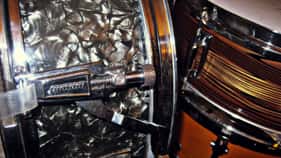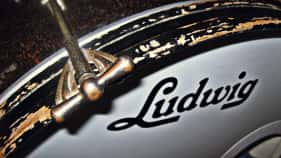
Snare Drum Tuning
Snare Drum Tuning – What’s So Important?
 Everything! The snare is the drum you hit probably 80-90% of the time. It needs to sound good for the context of the song you’re playing. This is especially true in the studio. In a day when drums can so easily be enhanced with samples or straight out replaced, it is easy to take a “get the performance and worry about the sounds in the mix” approach. Don’t.
Everything! The snare is the drum you hit probably 80-90% of the time. It needs to sound good for the context of the song you’re playing. This is especially true in the studio. In a day when drums can so easily be enhanced with samples or straight out replaced, it is easy to take a “get the performance and worry about the sounds in the mix” approach. Don’t.
Snare Drum Head Relationships
I talked about batter/resonant (aka top/bottom) head relationships in detail in my last entry. A snare drum follows all the same rules. Both heads tensioned the same gives maximum sustain. A tighter or looser resonant head will shorten the sustain and give a slight bend to the pitch of the drum (more pronounced with a looser bottom head). In addition, the snare has the actual snare wires which contribute to the sound. With snare drum tuning, I am less concerned with pitch bends and sustain as I am about how I want the bottom head to rattle the snares.
Do I want a longer buzz from the snares? I tighten the resonant head. Do I want more smack and less buzz? I loosen the resonant head. Of course, there are limits. If the resonant head is too tight, there’s not enough sustain produced in the drum to significantly rattle the snares and the drum is choked. If the head is too loose, you get a buzzy “splud” sound and no sustain. Of course, how the batter head is tuned in relationship to the resonant head changes the pitch of the drum and that too has an effect on how the snares vibrate.
Examples of Different Snare Tunings
Let’s listen to some examples as we explore the batter/resonant/snare wire relationship. In all the examples, I am using a 6.5×13” maple GMS snare drum with a single ply top coated head and an appropriate snare-side head. The batter head will always be tuned to a medium tension. The snare wires are tight enough to prevent excessive buzz and loose enough that I hear them even when tapping the drum very quietly with my stick (some guys make their snares so tight that hitting the drum quietly does not activate the snares and it sounds as if the snare wires are disengaged).
First, let’s listen to a batter and resonant head tuned as close as possible to the same pitch. Note how bright it sounds.
Now, let’s hear the drum with a looser resonant head (pitched lower than the batter head). Note the low end we get from the initial smack. The snare does sound a little more dull, and there is a little vibrato between the heads as the drum rings out.
Finally, let’s hear the drum with a tighter resonant head (pitched higher than the batter head). There is still a lot of low end in the smack. The drum does not sustain as long, but it has more cutting power and “crack” to it. Also, there is a slight pitch bend after the initial transient as opposed to the vibrato of the previous example.
Examples of Different Pitch Ranges
Snare drums are incredibly versatile. A really low tuned snare sounds “thuddy” and is great for a ballad or moody slow jam. A high tuned snare sounds “cracky” and articulate. I generally prefer a snare tuned in between those two ranges – high enough to speak well and cut, but low enough to provide body and sustained tone. That’s what you heard in the previous examples.
How Do I Tune a Snare?
Well, first it’s good to have a goal in mind for the kind of playing you will be doing. Does the snare need to cut through loud guitars (don’t tune low unless you’re mic’d)? Are you playing rock (usually medium to low tuning), urban gospel (usually so tight it hurts), pop (depends on the song and energy of the band), jazz (usually medium to high)? Remember too that drums have tuning ranges in which they sound best. Some snare drums like a lower or higher tuning than others. Pick the right snare for the job, then determine how high or low it should be pitched. Once you have a snare drum tuning goal in mind for what you hope to get from your snare, you will be well on your way to achieving it.
Again, numerous tutorials are available online that take one through the process of changing and properly tensioning a drumhead – no need to bore you there. Remember to seat the head and tune down to the desired pitch. I usually start with the snare-side head and have the drum on a carpeted surface so I only hear the head I am working on. I loosen the snare wires and place a stick underneath them so they are held out of the way of the head itself. Remember that with snare resonant heads, never use your palm to apply pressure and seat the head. Snare side heads are so thin that such pressure will distort or break the head.
Once I have a good tension on the resonant head, I remove the stick from the snare wires and turn the drum over. I tune the batter head to achieve more or less the pitch I want balanced with the feel and responsiveness I want. I then take the drum off the carpet and adjust the tension of the resonant head and batter head (snares still off) until I have a good sound. I then engage and tension the snare wires so that a light tap of the drum in the center of the batter head starts to rattle the snares ever so slightly. Listen to make sure that the snare wire tension does not choke the tone of the drum. I add muffling if necessary.
Additional Snare Drum Tuning Tips
- Sometimes 1 moon gel (gelatinous substance used to reduce ring on a drum) is too much. Cut a couple of moon gels in half and try that.
- Some Wal-Marts or online retailers sell the moon gel material in larger quantities for cheaper prices in the kids crafts section (you can get different colors too).
- Muffling a drum closer to or further away from the microphone sometimes makes all the difference in the studio.
- It sometimes pays off to tune your snare to the key of the song – especially if the snare is “ringy.” There’s nothing more annoying to me than a snare that is a quarter tone off or so from the song’s key signature – like nails on a blackboard.
- Get packs of “Lug Locks” for your tension rods – it helps (but does not totally prevent) the lugs from detuning after punishing rimshots.
- Technique makes a difference in snare tone. Let’s say you’re playing with rimshots (remember that a rimshot is when the stick hits both the rim and head of the drum simultaneously and does not, as some people use the term, refer to a side or cross stick when the rim is “clicked” with a stick laying across the batter head). If you want your rimshots a little deader, aim for the center of the snare head. More ring can be achieved by hitting the rimshot closer to the edge of the drum’s playing surface.
- Pay attention to your toms. Sometimes a snare sounds great and a tom sounds great, but when put together they sympathetically ring/buzz. In such a case, change the tuning of one of them.
- Coated heads will sound warmer and clear heads will have more attack. Single ply heads will allow for more ring and tone. Double ply heads will be deeper and fatter sounding while reducing a little of the sustain of the drum.
For more on honing your drum sound, check out my last entry on overall tuning.


